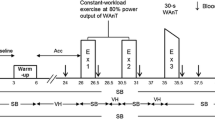Abstract
This study was performed to clarify the relationship between isocapnic buffering and maximal aerobic capacity (V˙O2 max ) in athletes. A group of 15 trained athletes aged 21.1 (SD 2.6) years was studied. Incremental treadmill exercise was performed using a modified version of Bruce's protocol for determination of the anaerobic threshold (AT) and the respiratory compensation point (RC). Ventilatory and gas exchange responses were measured with an aeromonitor and expressed per unit of body mass. Heart rate and ratings of perceived exertion were recorded continuously during exercise. The mean V˙O2 max , oxygen uptake (V˙O2) at AT and RC were 58.2 (SD 5.8) ml · kg−1 · min−1, 28.0 (SD 3.3) ml · kg−1 · min−1 and 52.4 (SD 6.7) ml · kg−1 · min−1, respectively. The mean values of AT and RC, expressed as percentages of V˙O2 max , were 48.3 (SD 4.2)% and 90.0 (SD 5.2)%, respectively. The mean range of isocapnic buffering defined as V˙O2 between AT and RC was 24.4 (SD 4.5) ml · kg−1 · min−1, and the mean range of hypocapnic hyperventilation (HHV) defined as V˙O2 between RC and the end of exercise was 5.8 (SD 3.0) ml · kg−1 · min−1. The V˙O2 max per unit mass was significantly correlated with AT (r = 0.683, P < 0.01). In addition, V˙O2 max /mass was closely correlated with both the range of isocapnic buffering (r = 0.803, P < 0.001) and RC (r = 0.878, P < 0.001). However, no correlation was found between V˙O2 max per unit mass and the range of HHV (r = 0.011, NS.). These findings would suggest that the prominence of isocapnic buffering, in addition to the anaerobic threshold, may have been related to V˙O2 max of the athletes. The precise mechanisms underlying this proposed relationship remain to be elucidated.
Similar content being viewed by others
Author information
Authors and Affiliations
Additional information
Accepted: 12 May 1997
Rights and permissions
About this article
Cite this article
Oshima, Y., Miyamoto, T., Tanaka, S. et al. Relationship between isocapnic buffering and maximal aerobic capacity in athletes. Eur J Appl Physiol 76, 409–414 (1997). https://doi.org/10.1007/s004210050269
Issue Date:
DOI: https://doi.org/10.1007/s004210050269




